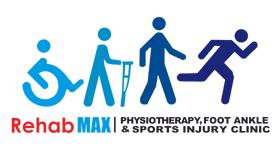Plantar Fasciitis may be the reason for your foot problems. If you are experiencing heel pain which is usually most severe when taking the first few steps of the day or after long hours of standing, then chances are that it is Plantar Fasciitis. Physiotherapy is an excellent way to cure this condition and reduce heel pain.
Plantar Fasciitis is mainly caused due to the inflammation of the plantar fascia, a dense fibrous connective tissue connecting the heel to the toes.
Plantar fasciitis is the most common cause of heel pain presenting in the outpatient setting. The exact incidence and prevalence of plantar fasciitis by age are unknown, but estimates do show that approximately one million patient visits per year are due to plantar fasciitis
Did you know that Runners are more likely to have Plantar Fasciitis?
You’ve probably heard about the connection between running and Plantar Fasciitis. Well, here’s why! The impact your feet absorb when you run can be as much as four times your body weight!
Studies indicate that Plantar Fasciitis accounts for about 10% of runner-related injuries and 11% to 15% of all foot symptoms requiring professional medical care2.
Can Plantar fasciitis go away on its own?
Usually, Plantar Fasciitis gets resolved on its own in around 6-8 months, in 80% of cases with simple stretching/exercises but if the pain is persistent and not reducing even a bit, then you need to consult a doctor for treating the same with medical management.3
What are some of the Plantar Fasciitis remedies at home?
Plantar Fasciitis can be managed at home with simple methods as mentioned below:
- Rest
- Apply ice
- Wear supportive shoes
- Replace old athletic shoes
- Stretch
- Massage
- Lose weight
But if the above methods do not work, please consult a doctor or a physiotherapist for the same.
What is the best treatment for Plantar Fasciitis?
Medical management of Plantar Fasciitis usually includes a variety of measures. It is best managed non-invasively by physiotherapy in 90% of the cases. However, surgical intervention may also be considered, generally as the last option.
Your treatment options include the following:
- NSAIDs (ebuprofen)
- Physiotherapy management
- Ultrasound (reduces inflamation)
- TENS (reduces pain)
- Stretching (sole of foot, calf, Achilles tendon, plantar fascia)
- Contrast bath (reduces inflammation and relaxes sole of foot)
- Strengthening of foot muscles (to avoid re-occurrence)
- Corticosteroid injection
- Surgical intervention
How does Physiotherapy help treat Plantar Fasciitis?
Physiotherapy in the acute/early phase of Plantar Fasciitis focuses on pain relief methods along with the various passive and active stretching techniques to relieve the stress posed on the fascia along with a reduction in the inflammation present.

Can Plantar fasciitis go away on its own?
- Therapeutic ultrasound is used over the posterior surface of the heel to reduce the pain as well as the inflammation.
- Contrast bath, i.e. keeping the foot dipped in hot water for 10 minutes followed by cold water immediately forms a very important part of the home program which helps in the reduction of pain.
- Other methods like using taping may be used for correcting the alignment of the bones of the foot which would be contributing to the pain and inflammation because of increased load on the fascia.
- Along with this, stretching of the plantar fascia, calf muscles, and tendon Achilles (fibrous band connecting the calf muscles to the heel bone) is taught to the patient and performed by the patient.
- As a part of chronic management of this condition, other therapeutic techniques like deep friction massage and iontophoresis could also be used, along with the basic stretching and pain-relieving techniques.
Curing plantar fasciitis also involves few lifestyle modifications that not only help cure but also prevent the re-occurrence of this condition.
- Basic changes like using firm and comfortable footwear and avoiding wearing heels for women are very essential.
- Footwear modifications like inserting an insole or using cushioned heel inserts help provide support as well as make the surface more stable and comfortable.
- Long hours of standing must be avoided and frequent short breaks must be taken to relieve the foot of the constant pressure.
- Reduction in body weight in the case of overweight and obese individuals also helps decrease the load on the foot/heel.

After the pain has considerably subsided and the muscles gained flexibility, strengthening exercises for the muscles of the foot are done to make the muscles strong enough to take the weight of the body and the repetitive stress and prevent injury. Lubricants and other intrinsic muscles of the foot are trained and strengthened.
Is walking good for Plantar Fasciitis?
Heel pain is a common foot condition. One may experience intense pain while you place weight on your heel. The pain usually builds up gradually and gets worse over time. Walking usually improves the pain, but it often gets worse again after walking or standing for a long time.
Is standing ok for Plantar Fasciitis?
Standing for long periods of time can put you on the fast track to developing Plantar Fasciitis.
Sometimes all it takes is standing still to develop heel pain. While standing in one place causes strain to be placed on a few muscles over a long period of time, rather than spread over numerous muscles, standing in place is much more conducive to the development of plantar fasciitis.
What are the causes of Plantar Fasciitis?
- Increased load on the fascia is the major cause of developing pain and inflammation, leading to stiffness.
- You are at a greater risk of developing plantar fasciitis if you are overweight or obese.
- Sudden weight gain may also lead to the development of plantar fasciitis.
- Pregnant women often experience bouts of plantar fasciitis, especially during late pregnancy.
- If you are a long-distance runner or athlete or have an active job that involves being on the foot often may also pose an increased risk of developing this condition.
- Having foot problems like very high arches, flat feet, and tight Achilles tendons also contribute to the factors causing pain and stiffness.
What are the symptoms of Plantar Fasciitis?
Heel pain is the primary symptom of plantar fasciitis. People often report their pain and stiffness are most intense during their first steps after getting out of bed or after prolonged periods of sitting; which may be exacerbated with the following:
- prolonged standing
- stair climbing
- toe raises
Plantar Fasciitis is a condition where there is inflammation of the fibrous connective tissue present in the soul of our foot. The fascia extends through the longitudinal arch of the foot and connects the heel to the front of the foot. This is an important static structure supporting the foot, taking up all the strain posed on the foot and hence helps us walk. As the load increases the fascia elongates to act as a shock absorber and support our body. Inflammation may start setting in due to the repetitive micro trauma to the tissue and the stresses placed on it, this leads to:
- Heel pain,
- Decreased mobility and
- Stiffness
Benefits of Physiotherapy in heel pain
Physiotherapy helps in dealing with the symptoms of plantar fasciitis like reducing pain, stiffness and inflammation. It helps make life more comfortable, less dependent and also prevents the consequences if treatment is taken well in time.
RehabMax Physiotherapy helps you in:
- Relieving your pain.
- Increasing the mobility of the tightened structures of the foot.
- Improving the strength of foot muscles.
- Making everyday life easy and pain-free.
What care do I need to take if I have Plantar Fasciitis?
Usually in any medical condition what-not-to-do is more important than what-to-do in order to avoid aggravating the painful symptoms and worsening the condition until you seek professional treatment. In the case of Plantar Fasciitis, these Don’ts also double up as ways to prevent future recurrence of Plantar Fasciitis.
Don’ts for Plantar Fasciitis
- Avoid excessive walking or running
- Avoid jumping or high-intensity exercises
- Do not walk bare foot.
- Untuck your bedsheets. If your sheets are tucked too tightly and you sleep on your back, your feet will be in a pointed position while you sleep
Do’s for Plantar Fasciitis
- Rest your feet
- Perform mild stretching for the sole of your feet [Read about Stretching Exercises]
- Apply ice
- You can perform low intensity exercises like swimming, cycling
- Lose weight as most of the body load is borne by the sole of your feet
- Choose proper footwear for activities to support your feet appropriately
- Replace your athletic footwear regularly / periodically
- Perform calf stretches [Read about Six Active Stretches ]
What happens if Plantar Fasciitis is left untreated?
If Plantar Fasciitis is left untreated for a long duration ie. for a year or so then it may transform into Plantar Fasciosis, where symptoms aggravate due to reduced / hampered blood supply to the sole of foot. This condition may require a surgical intervention.
Here are few fun facts related to Plantar Fasciitis:
FUN FACT 1: The feet contain a quarter of all the bones in your body!
A full quarter of the bones in your body are located in your feet–52 to be exact! When those bones are out of alignment, havoc can ensue, and plantar fasciitis is likely!
FUN FACT 2: Plantar Fasciitis misdiagnosis is common
Plantar Fasciitis isn’t always the culprit when it comes to heel and foot pain. If your pain isn’t going away, or if insoles and stretching make it worse, you might not have plantar fasciitis. Ligament tears and plantar fibromas are two of the leading conditions that masquerade as plantar fasciitis, or if you’re experiencing a lot of foot pain during the night, you may have tarsal tunnel syndrome.
FUN FACT 3: Stretching alone can improve or eliminate heel pain!
In a study published in the Journal of Bone and Joint Surgery, heel pain was either eliminated or much improved at eight weeks in 52% of patients who were treated with an exercise program to stretch the plantar fascia. Stretching to relieve symptoms of plantar fasciitis doesn’t work immediately–but for many people, it does work in the long term. [Read about Six Active Stretches ]



